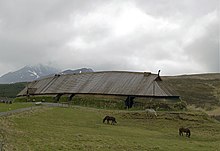Borg (Lofoten)
Borg is an archaeological site on Vestvågøy Island in Lofoten in Norway . A settlement was excavated there in the 1980s that existed from the 2nd century AD until the great plague wave in the 15th century. Investigations of fire places have shown human presence since the turn of the century. In the Viking Age (793-1066 AD) there were at least 115 farms with 1,800 residents.
location
Borg lies on a ridge that slopes steeply to Vestvågøy's two gulls, which were fjords in the Iron Age . Entry from the sea was difficult and dangerous for seafarers who did not know their way around. The oldest settlement is on the northern edge of the excavation area near Østad and was dated to the 2nd century. Three ship halls ( Naust ) were identified on the banks of the Gulf, two of which were large enough for long ships . The largest was 30 m long. A complex consisted of farmsteads that were grouped around a settlement. This settlement is viewed by archaeologists on the basis of similar shapes in other parts of the country as a kind of barracks for the chief's crew.
context
The discovery of the Iron Age hall in Gudme, Denmark (from the 3rd century) and in Borg in northern Norway marked a turning point in Northern European Iron Age research . While there were 12 indoor and central squares in Denmark in 1993, there were already 40 in 2003 when the Viking settlement of Füsing was discovered. In recent decades, in northern Europe , in the course of "central square archeology", especially in places that were rich Precious metal finds are marked, other halls discovered. Some of the so-called "wealth centers" have buildings that stand out in every respect from their surroundings.
The longhouse
The research focused on an extraordinary longhouse that was built in the 5th or 6th century. It had three aisles with two rows of roof-bearing supports and was initially 55 m long and 8 m wide. In the 8th, rather in the 7th century, the hall was enlarged. It was then 83 m long and between 7.50 and 9 m wide. Half of this building had always been used as a stable. This hall was abandoned between 950 and 1000.
The artifacts
The artifacts found in the hall are classified as particularly significant . Most of them are similar to those found in other settlements and homesteads and come from the younger Iron Age (600–1000): nails, iron knives, loom weights, glue stone vessels and spinning wheels. In addition, the earliest ceramic shards of imported goods from the Viking Age were found in northern Norway. Most of the shards come from jugs decorated with tin foil and geometric patterns. The vessels were probably made on the continent and may have served as wine containers. Fragments from imported glass cups are just as rare in Northern Norway. Over 100 pieces of 10-11 pieces of broken glass were found. Most are greenish, some are blue with attached glass threads. The shards of deep blue Reticella cups with melted glass threads in gold and blue should be emphasized . The glasses are also likely from continent that Reticella -Becher presumably from England . A special feature is a shard of glass with a thin gold foil in a geometric pattern, which is considered Carolingian .
In addition to pearls, eight gold objects were found, including five embossed square gold sheet figures and a ring made of gagat . A magical disaster preventive power has been ascribed to the gagat . The gold sheet figures represent a couple, the man on the left, the woman on the right. They are forerunners of the bracteates . They are assigned to the late Iron or Viking Age. Sometimes they are thought to be a means of payment, but the guldgubbe, which were also found in Denmark and Sweden and were also found here under the pillars, are mainly believed to have religious significance.
The interpretation
The interior design consists of the wooden floor in the side aisles, an elongated fire pit with fire pits in the middle and particularly deep fire pits at the end. This is interpreted to mean that the hall was also a reception room for guests and even a festival room for religious celebrations (blót). The deep pits at the end did not contain ashes and were probably lined with heated stones, on which the meat was placed, which was then covered, which would also explain the peat around the pits. An additional, separate fireplace is associated with religious sacrifices. This is also supported by the embossed gold plates and a gaga ring in or near the support holes. A dedication for the room is seen as an obvious interpretation.
Web links
Individual evidence
- ↑ Walter Christaller (1893–1969) was the founder of the " Theory of Central Places " in 1933 , the aim of which is to prove networks of neighboring mansions
- ↑ Munch p. 320.
literature
- Gerd Stamsø Munch: “Hus og Hall. En høvdinggård på Borg i Lofoten. ”In: Nordisk hedendom. Et symposium. Odense 1991. pp. 321-333.
- Gerd Stamsø Munch, OS Johansen, E. Roesdahl (eds.): Borg i Lofoten. A chieftain's farm in North Norway. Arkeologisk series 1. Tromsø 2003.
- Einar Østmo, Lotte Hedeager (ed.): Norsk arkeologisk leksikon. Oslo 2005.
Coordinates: 68 ° 14 ′ 24.2 " N , 13 ° 44 ′ 53" E

